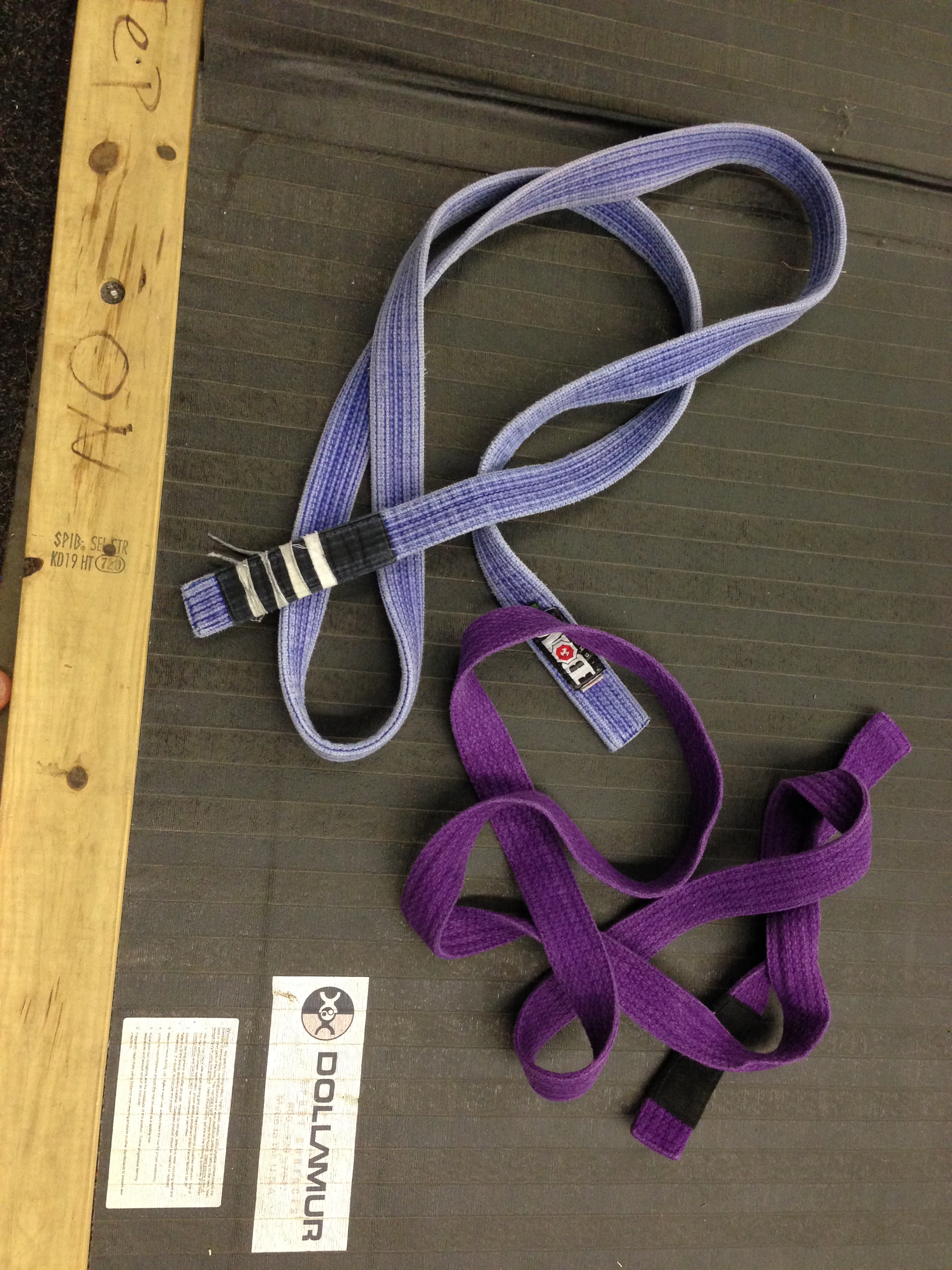Sometimes I think jiu-jitsu would be better without belts.
I understand the reasons for them: People love having markers of their progress, and they help for competitive fairness, and — my favorite aspect of belt promotions — I believe in any excuse to have a celebration. But belts are also controversial; every school has different standards, depending on whether the school emphasizes sport, self-defense, MMA, or a combination of those. Even within a school, those standards can change — sometimes radically. What a belt means might mean very different things depending on the student or instructor that you ask. Belt rank can feel arbitrary, and people can take them too seriously.
But BJJ belts are meaningful. They display to training partners what type of proficiency they can expect. They provide important waystations on the long journey. Most importantly: they contain memories. This alone means belts, whatever baggage they come with, have importance.
How should we think about belts, then?
I’m going to answer that question in a few different ways. First, I’ll explain what each belt level means to me, personally. Then, I’ll explain how that plays into the belt standards we’ll have for Bellingham BJJ. Finally, I’ll offer a few words of advice for how you should think (or not think) about belts while you train.
What follows, of course, is my own opinion. Every instructor has slightly different standards, which is good! No one is responsible for a belt they didn’t give. Accountability is good, though, too, and holding each other to high standards generally pays off in the end.
What each belt means to me
Blue belt means you know the fundamentals. You have two jobs at blue belt. Job one is to know the basics as well as you possibly can. Everyone defines “the basics” slightly differently, although you can get an idea of mine by looking at the BJJ blue belt requirements for Bellingham BJJ. To me, a blue belt has to learn what the instructor’s idea of the fundamentals are and know those basics cold.
Job two at blue belt: to see and try everything. In the video below, Jake Whitfield talks about this concept. Blue belt is about learning and exploring, and trying all the techniques that exist. Some of them will make sense to you immediately. Others will make sense over time. Others will never be your favorite moves. Try everything, though: you never know if you’ll have the potential to have an amazing butterfly guard unless you play around with it.
If you do these two jobs well, you’ll develop as a martial artist and have a great time. There is no shame at all to me in being a blue belt forever.
Purple belt means you are a seriously committed practitioner, a lifer. My instructor told me very early on that purple belt is the belt that draws a clear line: If he hands you a purple belt, that’s because he expects you’ll earn a black belt one day. I feel the same way. A purple belt should have a broad base of knowledge, the ability to roll well, and the ability to teach. I feel like a purple belt should be able to do more than execute technique — a purple belt should be able to pass along that technique to others, and to break it down in an understandable way.
Maybe because my instructor always put such an emphasis on it, purple was always a goal of mine. That said, it doesn’t have to be everyone’s goal. There are plenty of blue belts who are knowledgable, tough on the mats, and incredible gym contributors. At purple, though, we know you’re in for the long haul.
Brown belt means you have begun to develop your own jiu-jitsu. This should start at purple belt, but be refined at brown belt. If your job at blue belt is to see and try everything, at purple you should be beginning to define what your game is — and it should be a complete game. It’s acceptable for a blue belt to have a limited understanding of certain positions — a blue belt can be successful in competition as just a top player or just a guard puller, but a purple and especially a brown belt must be well-rounded.
That doesn’t mean you have to do everything all the time; as I said, you should be defining your own game during your purple belt years. But if a white belt or a blue belt asks you for help on their guard, it doesn’t matter if you’re a beast wrestler that can crush the life out of other browns and even black belts during matches — you’ve got to be able to give them that technical advice.
Black belt means you have your own jiu-jitsu and are ready to represent the art positively. This, for me, goes beyond technical ability or toughness. I’ve been very lucky to have amazing coaches with a real passion not only for doing jiu-jitsu, but for sharing it with the world. The black belt means a different thing to everyone, but that’s what it means to me.
With that being said, how do I think about belts at Bellingham BJJ?
What belt promotions will be like at Bellingham BJJ
There are only five belts in jiu-jitsu, and only four belt promotions: these should be earned, and enjoyed. Our lineage goes through Royce Gracie black belt Seth Shamp, who gave me my black belt. I’ll be listing all expectations on the school policies page, since clarity helps.
There are specific standards for each belt that Bellingham BJJ will have access to. Here are the list of blue belt requirements, purple belt requirements, brown belt and black belt requirements. With that said, though, I think more about principles than I do about checking off boxes when I think about what constitutes grounds for promotion, even a stripe promotion.

Here are some of those principles:
It will be difficult to get a belt from me. High standards are good: they send a message about hard work. A difficult achievement is one you can be proud of, and I don’t want promotions to come easily. I can say personally that knowing how hard I worked for my belts and how high my instructors’ standards are made the belts mean more to me.
I will re-think belt requirements every three months. I don’t anticipate fundamental changes to this list, but there are always techniques that are on the border and might be added or subtracted — or, if I figure out a better way to show a move, that might be reflected there as well.
Knowing the techniques on the list is a minimum standard, not a checklist. The list of requirements just includes those techniques that I really think a person of that belt level needs to know. For purple and up, there are “dealer’s choice” options as well: for example, purple belts need to be able to demonstrate two guard passes not on the requirement list. That’s because this is the time that you should be defining what your jiu-jitsu looks like, and how it differs from mine.
When I think about promotions, I think about many things: time spent training, dedication, attitude, technical knowledge, and ability to execute while sparring. In general, that breaks down this way:
Ability to execute techniques (i.e. rolling, competition): 30%
Knowledge of techniques (i.e. technical understanding): 30%
How do you represent the art? (Do you have a positive attitude? Do you represent jiu-jitsu well?): 20%
Commitment to the school & the art (have you put your time in?): 20%
Those percentages are going to be different for every person, though. Someone with natural athletic ability and aggression will probably have a head start on some of these; that doesn’t mean that people without natural physical gifts can’t earn all the same belts.
Finally, let me say this: don’t worry too much about belts, and never ask when someone is getting promoted. Jiu-jitsu is something we do because we love it, and the process is what matters. All problems in jiu-jitsu, and in life, can be solved by simply continuing to train.
Enjoy the road, not the signposts. Every day we train is a gift, and should be celebrated. Again: any excuse for a celebration.

